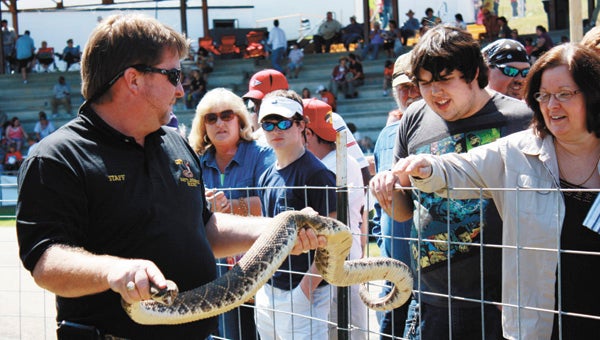Group wants to protect rattlesnakes
Published 12:06 am Wednesday, August 24, 2011

Opp City Councilman Scotty Short shows spectators an Eastern Diamondback rattlesnake at this year’s event. | Kendra Bolling/Star-News
A move to place the Eastern diamondback rattlesnake on the endangered species list is being met with disbelief from locals – including an Opp woman whose son died from a rattlesnake bite.
On Monday, a partnership of wildlife conservation groups and a snake researcher filed a petition to protect the animal under the Endangered Species Act, citing habitat destruction and “rattlesnake roundups” like the Opp Rattlesnake Rodeo as reasons for the demise of the snake.
Opp city planner Don Childre, who is active in the rodeo, said he disagrees with the numbers the organization used as a basis for their claim of declining numbers.
“Some of the data (these organizations) have pertain to the Rattlesnake Rodeo,” Childre said. “It says that that we had close to 400 snakes in the 1970s, and then said we only had 25 the first year the city had the rodeo. That’s because I told the mayor that I didn’t want to deal with 300 to 400 rattlesnakes. We could get 300 if we wanted them.”
Childre said proponents of the petition also claim the average size of the snakes has fallen off; however, they haven’t weighed the snakes from the rodeo.
“I have the only key to the pen, and I know for a fact (they haven’t) weighed them,” he said.
“There is no way that I can be convinced that (rodeo officials are) having any more impact (on the snake population) than people that kill them in their backyard,” he said.
Childre said the petition will take multiple years to pass, but said he really isn’t worried about it passing.
If anyone knows the horrendous effects a rattlesnake bite can have, it’s Mary Charles Wyatt, whose son, 4-year-old Dee, was bitten in 1974.
Wyatt said her son was playing ball in the family’s yard with a friend, when the ball landed in the middle of two “very large” Eastern diamond back rattlesnakes.
Wyatt said both snakes struck him in the back of the knee.
“He lived about 11 and a half hours after that,” she said.
Wyatt said she and her husband took him to the emergency room in Opp, where Dr. Wheeler Gunnels administered 14 vials of anti-venom.
Wyatt said her little boy wasn’t the first in her family to be killed by a rattlesnake.
“He was the third in my husband’s family and the second in mine,” she said. “I didn’t even know that until after this happened.”
Wyatt said this isn’t the first effort to put the Eastern diamondback on the endangered species list.
“We’ve had this come up years ago,” she said. “We wrote letters and got a petition (against the other petition). Within five hours we had about 4,000 signatures.”
Wyatt said she’ll do anything she needs to do in order to ensure the snakes are not placed on the endangered species list.
“If they think the Eastern diamondback rattlesnake is becoming extinct, they can come to my home, and I’ll put them on some,” she said. “They are all down here. In fact, about six weeks ago, there was one under my carport. They are not extinct in this area. I have some friends who would sack them up and put them in galvanized garbage cans and dump them in their yards.”
Local biologist Mark Bailey said the federal listing would be far off, as the petition initiates a formal, multi-year review process under the Endangered Species Act to determine whether the diamondback warrants protection as a threatened species.
“I think the Fish and Wildlife Service has more species that are in more trouble,” he said. “The rattlesnake population is declining. They are absent from large portions (of their habitat), but are not on the verge of extinction.”
It is estimated that just 3 percent of the historic population remains; however, Bailey said he’s seen five or six Eastern diamondbacks this year.
“They are part of our environment and they have a place,” he said. “I understand someone wanting to kill one that is near where their kids play, but they are persecuted way more than your average species.”
Bailey said the No.1 cause of the decline is the loss of habitat.
“They are being pushed back everywhere,” he said. “They still live in places where people might not think they need. They don’t require pristine long leaf pines.”
Bailey said the state conservation department already considers the snake a species of special concern.




